Recreating the Country blog |
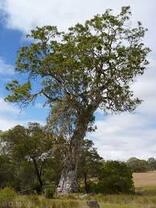 Bilston's tree is a River Red Gum near Casterton that is 800 years old. It stands over 40m tall with a girth of 7m. Bilston's tree is a River Red Gum near Casterton that is 800 years old. It stands over 40m tall with a girth of 7m. Paddock trees in decline Phillip Adams is the ABC presenter of Late Night Live and an Ozzie legend. When I get the chance I listen to Phillip, hoping to absorb some of his remarkable understanding of world affairs. I’m disappointed to report that my hope is usually in vain. Though my ears did prick-up recently when he was introducing English author James Canton. His book ‘‘The Oak Papers’ follows the extraordinary life story of an 800 year old Honeywood Oak tree at ‘Marks Hall Estate’ in Coggeshall, Essex. (Australia has a River Red Gum of the same vintage. See image on left - Bilston's tree) In his introduction Phillip reports that his own experience with ancient trees has been very disappointing. Many of the century old native trees on his ‘Elmswood’ property in NSW died during the millennial drought. Unfortunately Phillip’s experience isn’t unique and reflects a pattern of ancient tree decline and loss throughout Australia. I think we all should be concerned that 2% of our old trees are dying each year. Of even greater concern is they are not being replaced. This was the disturbing finding of an extensive 1,000,000 ha study of old paddock trees in the SE of Australia by ANU researcher Dr Joern Fischer in 2009. This worrying trend has not improved in the last eleven years and is actually accelerating.  The post apocalyptic city shown here is to help us appreciate the homes lost to wildlife each year in Joern Fischer's study area alone The post apocalyptic city shown here is to help us appreciate the homes lost to wildlife each year in Joern Fischer's study area alone A city the size of Melbourne lost every year Putting this 2% annual death rate into a human context. If we estimate 5 old trees/ha in Joern Fischer’s study area each with 30 hollows/tree. The overall loss is a staggering 100,000 trees with 3,000,000 hollows lost annually as the dead trees collapse. In human terms this is a city the size of Brisbane or Adelaide falling into ruin every year. Ecologists describe old paddock trees as ‘keystone features’ in our rural landscapes. Their loss translates into the loss of the many dependent insect and animal species living in and around the old trees. Particularly the 300 plus species of wildlife that need tree hollows. Click here to Paddock trees - part 1. Their beauty and their bounty for more on this topic 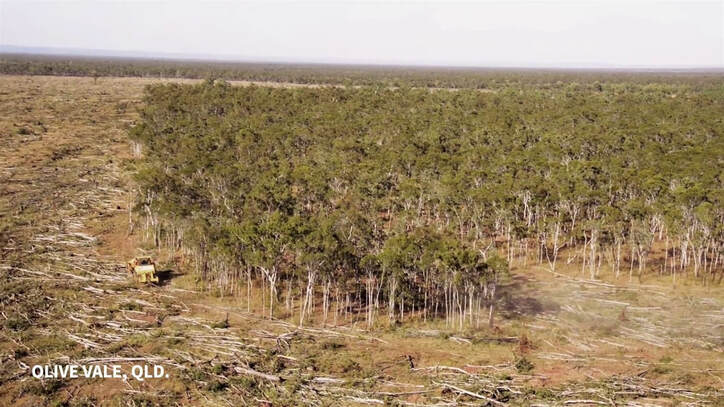 Clearing native vegetation in Australian is continuing at alarming rates Clearing native vegetation in Australian is continuing at alarming rates Clearing on our watch ...and is it legal? Paddock trees and standing dead trees are still being cleared for plantation establishment, firewood collection and paddock management purposes. They are part of a large study that reported; 'Deforestation in Australia: How does your state (or territory) compare'? This article vividly reveals the clearing done between 2010 - 2018 in each state. For example Victoria cleared the equivelant of a 1-kilometre-wide piece of land extending from Hobart to Brisbane. NSW cleared an area equivalent to a 1-kilometre wide strip extending 7,000 km from Perth to Cairns via Brisbane. This is a depressing report card isn't it.
Now for an inspiring story; 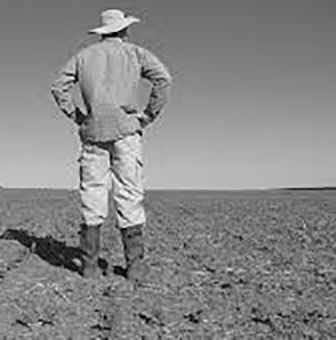 One farmer’s vision - a 100 year plan In our early years in the nursery we were fortunate to befriend a couple who had been planting trees for shelter on their farm since the early 1950’s. John and Janice Morrison were pioneers in the industry and enthusiastic about the conservation benefits of planting several thousand trees and shrubs each year. John had another tree planting strategy that was both remarkable and inspiring. It was a plan that would take his family over 100 years to complete. He had divided his 4,000 acre property roughly into ten areas of 10% or 400 acres. His plan was to take 10% out of production for 10 years. This meant no grazing and no cropping. During this ten year period the family would plant well-spaced paddock trees to provide shade and wind shelter. After ten years another 400 ha would be set aside, while the first area was put back into production. There were clear advantages to this radical plan. It allowed the Morrison family to plant paddock trees very cheaply and conveniently, because there were no large and expensive stock proof tree-guards required. It also allowed easy access to the young trees for care and maintenance.  An example of allelopathy on Morrison's farm - young River Red Gums (on the left) have germinated beyond the canopy of the mother paddock tree. An example of allelopathy on Morrison's farm - young River Red Gums (on the left) have germinated beyond the canopy of the mother paddock tree. ... and there was natural regeneration – what a bonus! A significant added bonus to this forward thinking plan was the existing century old paddock trees on the property started to regenerate. It was amazing to see the hundreds of River Red Gums germinating beyond the tree canopies beside the mature ‘mother’ trees. These trees quickly reached five meters tall in 3 – 5 years. This meant that they needed no stock protection beyond this time, though they had another 5 years to 7 years to strengthen with John’s ten year plan. Click this link to read about funding to protect paddock trees 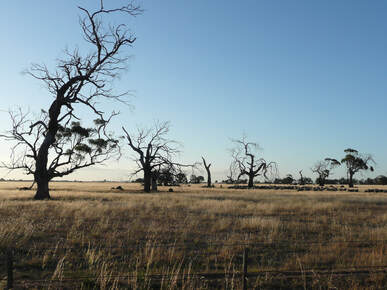 Continuous grazing practices don't allow paddock trees to regenerate Continuous grazing practices don't allow paddock trees to regenerate Changing management practices Old paddock trees produce a lot of seed every year. River Red Gums for example produce on average 500 viable seeds per gram (that's about half a teaspoon). This seed is dispersed into the surrounding landscape in autumn where it lies in wait for the first soaking spring rains. Every old paddock tree literally produces millions of fertile seed that have the potential to grow into paddock giants. These seeds are ready, willing and able. Our challenge is to provide them with the opportunity. The traditional farming practice of continuous grazing doesn’t allow paddock trees to regenerate. Permitting stock to have general access to paddocks for long periods results in intense grazing of everything green include tree seedlings. I have surveyed areas around mature eucalypts and have found young trees with sizeable stems nibbled off to just 5cm tall. I have also witnessed the extraordinary transformation of these young trees when stock is removed for as little as 12 months. They quickly grow to heights over 3 meters because of their well-established roots. Resting paddocks for periods of 12 months is often enough time for seeds to germinate and for young trees to emerge. How can we help emerging trees establish before grazing pressure is returned? 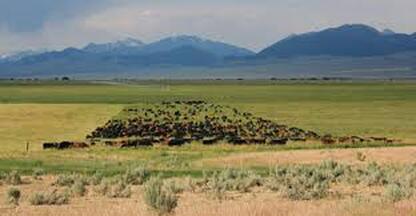 High Intensity Rotational Grazing in Colorado, USA High Intensity Rotational Grazing in Colorado, USA High Intensity Rotational Grazing High Intensity Rotational Grazing promotes dramatically increasing stocking numbers and moving animals frequently. In this system stocking rates for cattle can increase by more than 500 times and at this rate they may need to be moved daily. This technique can result in enhanced soil health and improved pasture condition if it is done well. Click here to read more about High Intensity Grazing from the 'Noble Research Institute', Oklahoma I have seen this system used at Healsville, Victoria on a 300ha farm which was divided into 0.5ha plots with mobile electric fencing. The farmer dramatically increased his soil fertility and pasture health. In this example the cattle were followed by chooks for egg production. Increasing the natural regeneration of paddock trees Dr. Joern Fischer from the Australian National University recommends this grazing method to increase the regeneration of paddock trees. He observed a fourfold increase in natural regeneration where sheep were grazed intensely in small paddocks for a few days and moved on. The grazed paddocks were then rested for three or more months. Three months rest in spring is enough time for seeds to germinate. Small trees can then be guarded or temporarily fenced-off until they establish. Fischer observed trees regenerated best in soils with low fertility and recommended that fertiliser applications near trees be minimised to improve the success of tree regeneration. 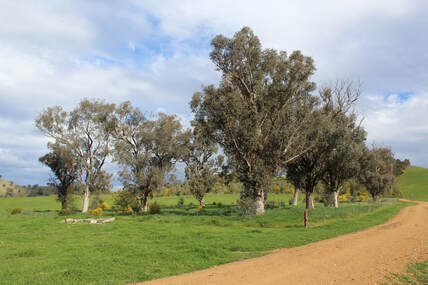 Paddock trees ring fenced to promote natural regeneration and planting shrub species. photo: Sustainable Farms website. Click on photo to visit this site Paddock trees ring fenced to promote natural regeneration and planting shrub species. photo: Sustainable Farms website. Click on photo to visit this site Semi-permanent fencing Isolated paddock trees Paddock trees located a long way from boundaries can be temporarily ring-fenced for 2 – 5 years until regenerating seedlings are big enough to tolerate stock grazing, browsing and rubbing. This is a relatively cheap method because large numbers of young trees are protected. Trees within the fenced area may need to be individually guarded to protect them from rabbits and hares. Ringlock, cable-tied to star pickets should be adequate to keep out stock for short periods. This can be quickly and conveniently moved to another site by cutting the plastic cable ties and lifting the star pickets. Fencing well beyond the canopy of the old trees is important because seedlings won’t germinate underneath because of allelopathy. This is a natural process used by plants to reduce competition. Mature trees drop growth inhibitors with their leaves to protect their own growing space and to prevent overcrowding. 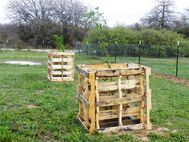 Recycled pallets make a solid and secure treeguard for paddock trees Recycled pallets make a solid and secure treeguard for paddock trees Cheap and effective stock proof tree guards Individual stock proof tree guards need to be solid and can be expensive, unless waste products like used rabbit netting, old wooden pallets or 44 gallon drums are used. Peter and Julie Waldron from western Victoria were part of the Potter Farms project, funded in the mid-1980s by the Ian Potter Foundation. Peter guarded his newly planted River Red Gum paddock trees with used 44 gallon drums. When the trees reached the top of the drum he added a large old tractor tire. The tires were much wider than the drums and prevented his cross-bred sheep from reaching up and browsing on the young trees. A very convenient and cheap tree guard, advocated by Rowan Reid, Australia’s agroforestry guru, is a ‘vine-guard’ cable-tied to a 2m length of flexible 16mm plastic conduit. This guard bends when animals push against it, but it springs upright when released. Seedlings quickly grow to the top of the guard and are able to move in the wind which is important to encourage strong root development. (Hover on images below to read the caption) 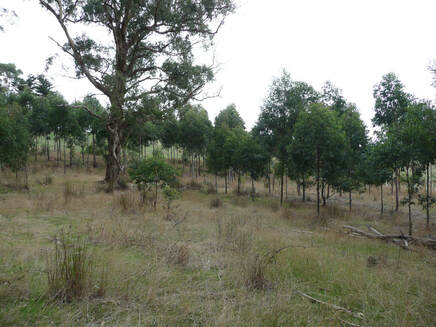 Paddock trees can be incorporated into new plantations along fence lines and waterways Paddock trees can be incorporated into new plantations along fence lines and waterways Permanent fencing Paddock trees near boundary fences or on waterways Paddock trees growing near boundaries and creeks can be fenced into windbreaks and biodiversity plantings. This allows the old trees to be protected permanently and enhances biodiversity plantings immeasurably. The hollows and other habitat provided by the old trees gives new plantations a maturity that would normally take hundreds of years to achieve.
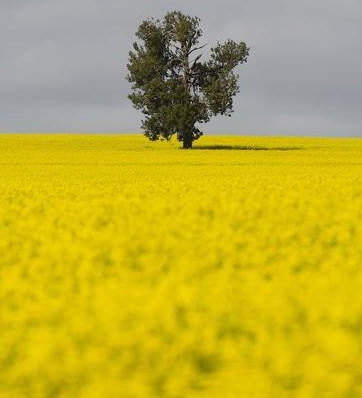 Planting less competitive tree species like River Red Gum, E. Camaldulensis, while a paddock is in crop saves on expensive tree guards Planting less competitive tree species like River Red Gum, E. Camaldulensis, while a paddock is in crop saves on expensive tree guards Cropping paddocks can be planted with paddock trees at very low cost and for a huge gain locally and nationally Restoring paddock trees across rural areas is as simple as planting a seed. If every hectare of open paddock in Australia had 5 to 10 scattered shade trees, our climate and our living environment would improve immeasurably. Millions of tonnes of carbon would be sequestered every year, the quantity of carbon being taken from the atmosphere would increase exponentially as the trees grew toward maturity. See Paddock trees-part 1 & Paddock trees-part2 to appreciate of the benefits. A cropping paddock is the perfect place to start planting because the biggest threats to new trees (grazing and browsing animals) have been removed. Cropping for a period of 2 – 3 years is enough time to cheaply and painlessly fully establish paddock trees without the need for tree guards. 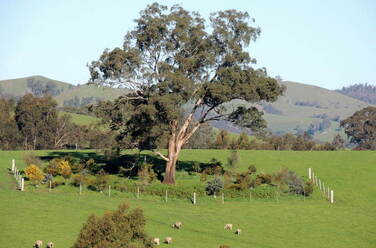 Click on the image to read about the Upper Goulburn Landcare Networks 'Paddock Trees Project'. Click on the image to read about the Upper Goulburn Landcare Networks 'Paddock Trees Project'. Enhancing germination ... at a glance
Planting paddock trees... accelerating the benefits 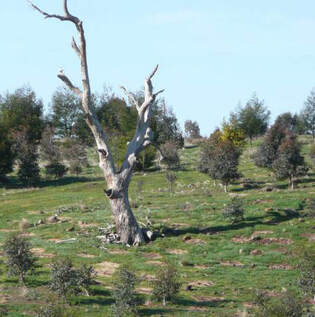 Paddock trees planted in groups accelerates their benefits. Incorporating old stags protects the hollows and the ecologies they support Paddock trees planted in groups accelerates their benefits. Incorporating old stags protects the hollows and the ecologies they support The ideal paddock tree species for your location will be found on your local roadside remnants and reserves. Choosing local species ensures that your paddock trees will support the life-cycles of local wildlife and continue to be 'keystone' landscape features. The ideal plants will be tall enough to provide significant shade for livestock. They will also have deep root-systems and fewer surface roots to compete with crops and pastures. Local knowledge is usually helpful with this choice. Other farmers, Landcare facilitators and native nurseries may know which plants don't make good paddock trees. I remember driving around a farm at Inverleigh with an experienced farmer. He referred to his Manna Gum, E. viminalis, paddock trees as 'bastard gums' because they soured the grass growing underneath making it unpalatable for his sheep. To rapidly get the benefits of having mature paddock trees in your paddock, plant in groups of five with a spacing of 3 – 5 metres between each tree. This provides significant habitat for wildlife and stock in a very short time. Group planting multiplies and accelerate the ecological benefits making it similar to a 50 – 75 year old tree in just 10 – 15 years. As they mature beyond 15 years some trees can then be harvested for their timber. These clumps can be planted every 30 - 50 meters which will result in 5 - 10 paddock trees/hectare 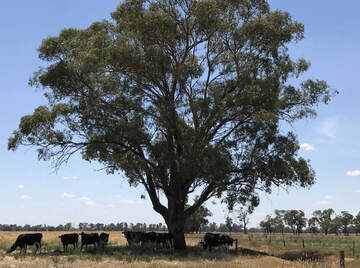 Stock sheltering under paddock trees raise soil nutrient levels and cause compaction Stock sheltering under paddock trees raise soil nutrient levels and cause compaction What could go wrong?... farming practices that weaken old trees
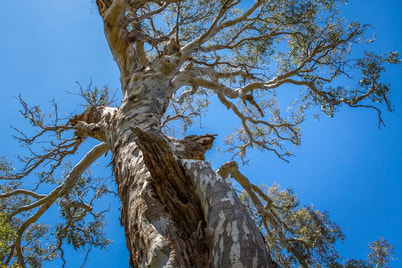 The typical appearance of dieback in a eucalypt The typical appearance of dieback in a eucalypt Dieback is reversible When paddock trees become stressed for a long period their branches drop leaves and become bare. Often they will shoot again from further down the trunk but the dead limbs from an earlier dieback event are still visible.
Click here to read this excellent review of the causes of dieback 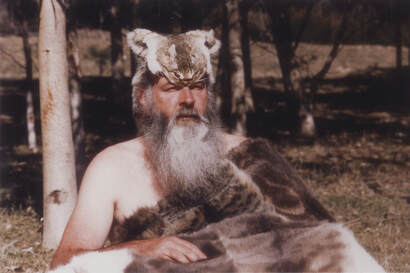 Dr John Walmsley became famous for wearing a hat and cloak made from feral cat skins, Dr John Walmsley became famous for wearing a hat and cloak made from feral cat skins, Valuing nature When Dr. John Walmsley established 'Warrawong' the first of his Earth Sanctuaries' in 1969, he wanted Australians to protect and value native wildlife. In the year 2000 when he floated Earth Sanctuaries Limited (ETL) he proposed putting a value on all the wildlife protected in his eleven sanctuaries. For example, a threatened Eastern Quoll was valued at $1,250, a rare Pademelon came to $2,500 and an endangered Bilby was worth $5,000. ETL at that time valued all the wildlife in its care at $3,800,000 Following John Walmsley's example, what value should we put on a century+ old paddock tree. We could pay $50 for a three year old eucalyptus tree to plant in our gardens. What price would we put on 300 year old eucalypt with hollows. $50 x 100 = $5,000 is very conservative. Using this figure, the 100,000 trees lost each year in Joern Fischer's study area would then be valued at a staggering half a billion dollars. This is just a single pixel on a computer screen or a fragment of Australia's overall paddock tree loss through clearing and poor management each calendar year. Though how can we put a value on something so irreplaceable, so priceless? Its futile to quantify in dollars the extraordinary and unacceptable losses to Australia's heritage that we are witnessing in our lifetimes. Yet all is not lost if we focus our hearts and minds on protecting these irreplaceable national treasures. I'm hopeful that we will see the current pattern of losses turned around in the next decade. The nations State governments are beginning to choose a better path toward to meet the climate-change crisis, though our Federal Government continues to drag its feet. I believe that the nations health depends on paddock trees being reestablished across our broad and timeless landscapes - click here to read why. This will be a remarkable achievement but entirely necessary to support the many and varied ecologies to which these trees are unquestionably critically important 'keystone' features. You may have missed; 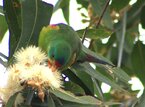 
0 Comments
Leave a Reply. |
Click on the image below to discover 'Recreating the Country' the book.
Stephen Murphy is an author, an ecologist and a nurseryman. He has been a designer of natural landscapes for over 30 years. He loves the bush, supports Landcare and is a volunteer helping to conserve local reserves.
He continues to write about ecology, natural history and sustainable biorich landscape design. 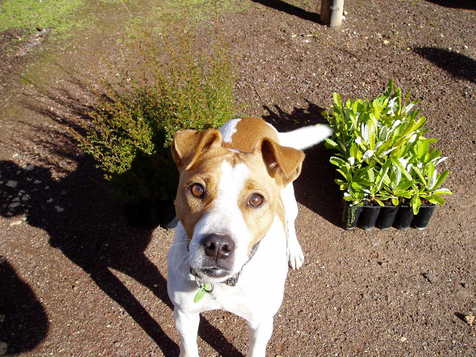
|
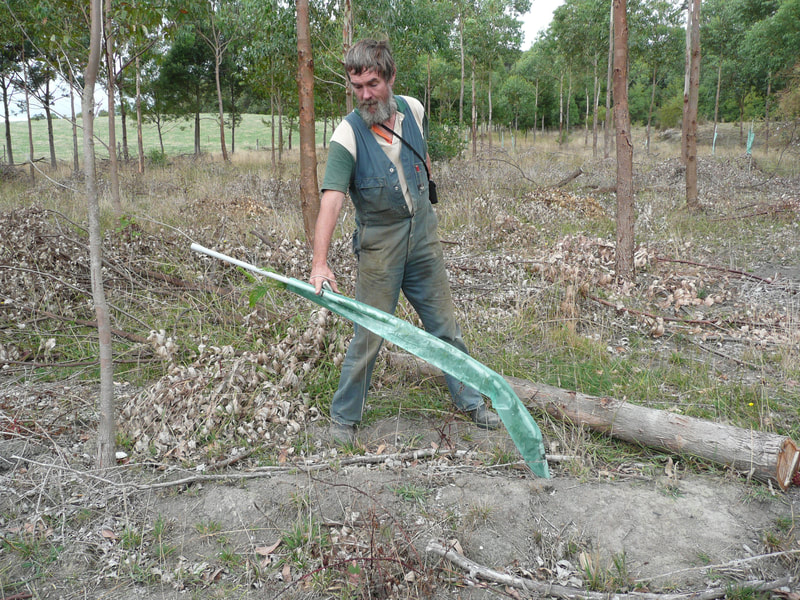
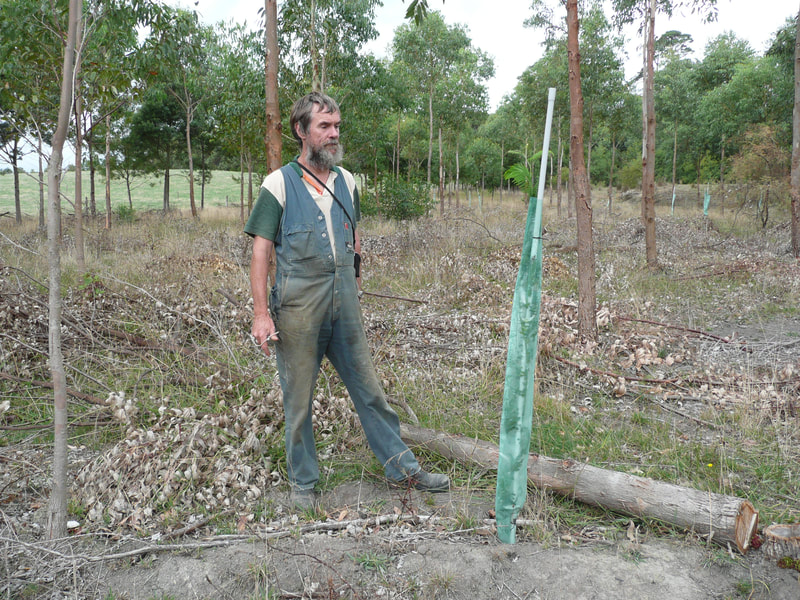
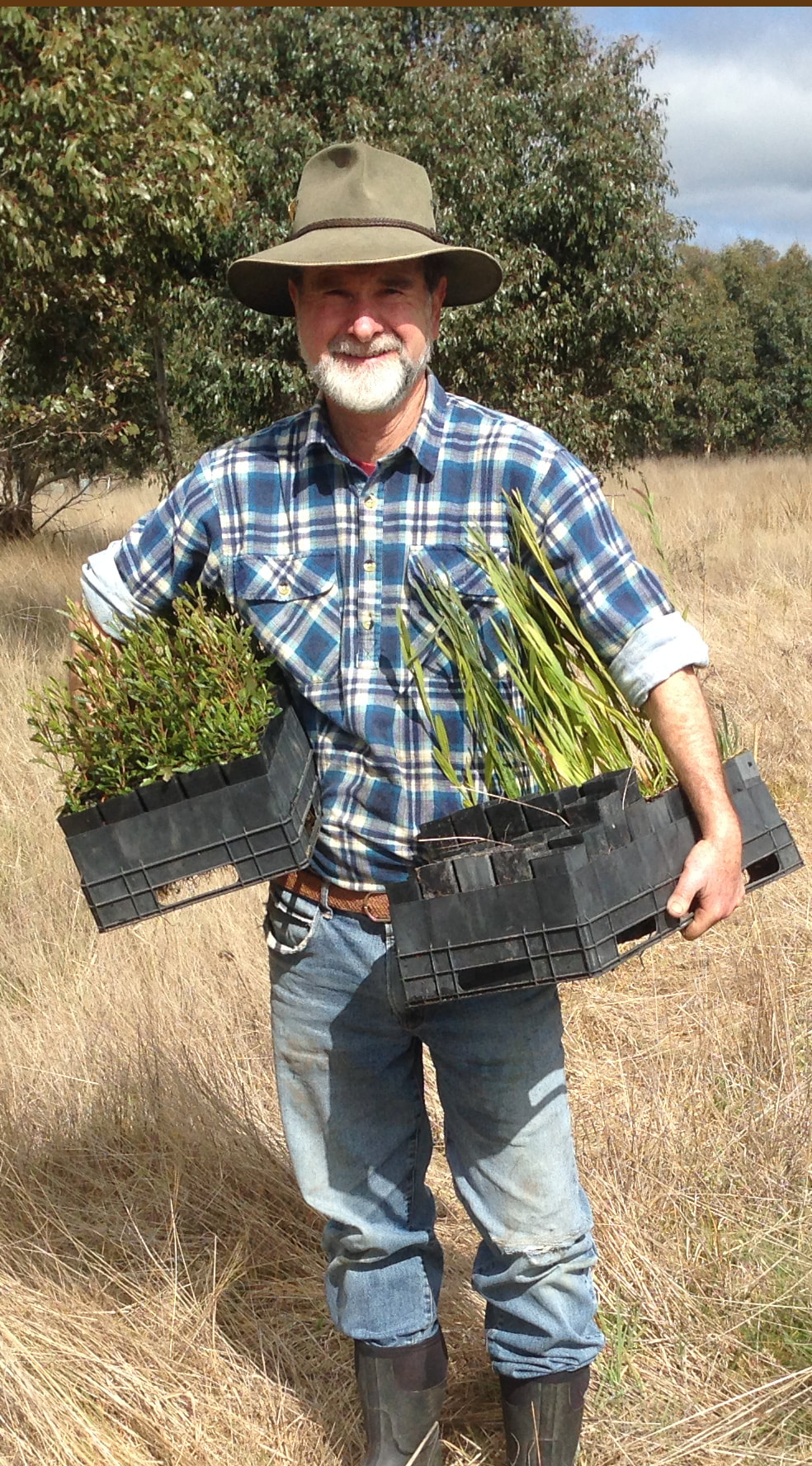

 RSS Feed
RSS Feed
